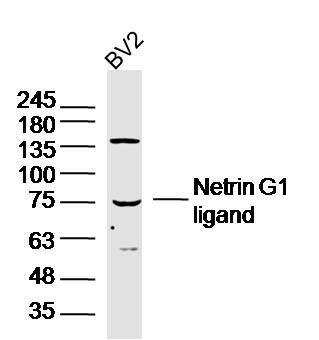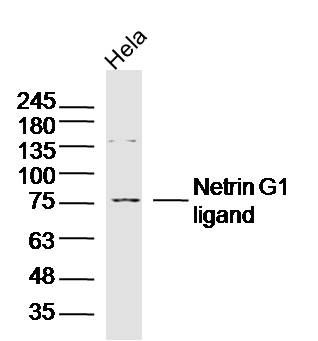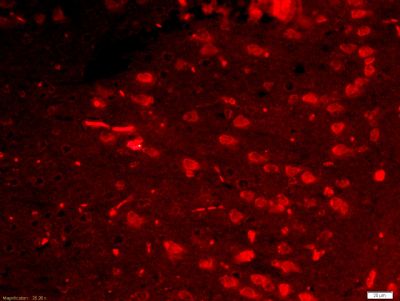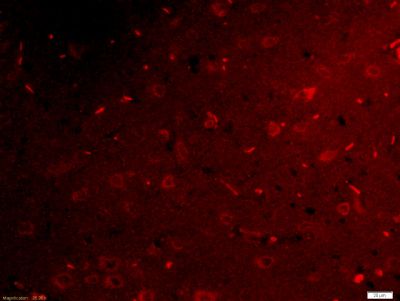| 中文名称 | 轴突生长诱向因子G1配体抗体 |
| 别 名 | Leucine rich repeat containing 4C; Leucine-rich repeat-containing protein 4C; LRC4C_HUMAN; Lrrc4c; Netrin-G1 ligand; NGL 1; NGL-1; NGL1. |
| 研究领域 | 神经生物学 信号转导 生长因子和激素 |
| 抗体来源 | Rabbit |
| 克隆类型 | Polyclonal |
| 交叉反应 | Human, Mouse, Rat, (predicted: Dog, Cow, Horse, Rabbit, ) |
| 产品应用 | WB=1:500-2000 ELISA=1:500-1000 IHC-P=1:100-500 IHC-F=1:100-500 IF=1:100-500 (石蜡切片需做抗原修复) not yet tested in other applications. optimal dilutions/concentrations should be determined by the end user. |
| 分 子 量 | 70kDa |
| 细胞定位 | 细胞膜 |
| 性 状 | Liquid |
| 浓 度 | 1mg/ml |
| 免 疫 原 | KLH conjugated synthetic peptide derived from human Netrin G1 ligand:561-640/640 |
| 亚 型 | IgG |
| 纯化方法 | affinity purified by Protein A |
| 储 存 液 | 0.01M TBS(pH7.4) with 1% BSA, 0.03% Proclin300 and 50% Glycerol. |
| 保存条件 | Shipped at 4℃. Store at -20 °C for one year. Avoid repeated freeze/thaw cycles. |
| PubMed | PubMed |
| 产品介绍 | NGL-1 is a single pass type I membrane protein that acts as a cell adhesion molecule. It contains nine leucine-rich repeats (LRR) and one Ig-like C2-type domain. NGL-1 is predominantly expressed in the striatum and the cerebral cortex of both the embryonic and adult brain. NGL-1 specifically interacts with Netrin G1 (a molecule involved in axon guidance in the developing central nervous system) via its LRR region. NGL-1 plays a role in the regulation of neurite outgrowth of developing thalamic neurons. Soluble NGL-1 inhibits thalamic axon outgrowth while NGL-1 that is bound to the surface of developing thalamocortical axons stimulates growth. NGL-1 also interacts with Whirlin possibly stablizing interstereociliar links. Function: May promote neurite outgrowth of developing thalamic neurons. Subunit: Interacts with NTNG1 and WHRN. Subcellular Location: Membrane. Tissue Specificity: Highly expressed in the cerebral cortex, including frontal, parietal and occipital lobes. Putamen, amygdala, hippocampus and medulla oblongata show moderate expression. Caudate nucleus and thalamus express small amounts, whereas other brain regions show very weak or no expression. Similarity: Contains 1 Ig-like C2-type (immunoglobulin-like) domain. Contains 9 LRR (leucine-rich) repeats. Contains 1 LRRCT domain. Contains 1 LRRNT domain. SWISS: Q9HCJ2 Gene ID: 57689 Database links: Entrez Gene: 57689 Human Entrez Gene: 241568 Mouse Entrez Gene: 311236 Rat Entrez Gene: 553785 Zebrafish Omim: 608817 Human SwissProt: Q9HCJ2 Human SwissProt: Q8C031 Mouse Unigene: 745123 Human Unigene: 241682 Mouse Unigene: 482999 Mouse Unigene: 219303 Rat Important Note: This product as supplied is intended for research use only, not for use in human, therapeutic or diagnostic applications. |
| 产品图片 |  Sample: BV2 Cell (Mouse) Lysate at 40 ug Sample: BV2 Cell (Mouse) Lysate at 40 ugPrimary: Anti- Netrin G1 ligand (bs-6710R) at 1/300 dilution Secondary: IRDye800CW Goat Anti-Rabbit IgG at 1/20000 dilution Predicted band size: 70 kD Observed band size: 76 kD  Sample: Hela Cell (Human) Lysate at 40 ug Sample: Hela Cell (Human) Lysate at 40 ugPrimary: Anti- Netrin G1 ligand (bs-6710R) at 1/300 dilution Secondary: IRDye800CW Goat Anti-Rabbit IgG at 1/20000 dilution Predicted band size: 70 kD Observed band size: 76 kD  Tissue/cell: mouse brain tissue;4% Paraformaldehyde-fixed and paraffin-embedded; Tissue/cell: mouse brain tissue;4% Paraformaldehyde-fixed and paraffin-embedded;Antigen retrieval: citrate buffer ( 0.01M, pH 6.0 ), Boiling bathing for 15min; Blocking buffer (normal goat serum,C-0005) at 37℃ for 20 min; Incubation: Anti-NGL1 Polyclonal Antibody, Unconjugated(bs-6710R) 1:200, overnight at 4°C; The secondary antibody was Goat Anti-Rabbit IgG, Cy3 conjugated(bs-0295G-Cy3)used at 1:200 dilution for 40 minutes at 37°C. DAPI(5ug/ml,blue,C-0033) was used to stain the cell nuclei  Tissue/cell: rat brain tissue;4% Paraformaldehyde-fixed and paraffin-embedded; Tissue/cell: rat brain tissue;4% Paraformaldehyde-fixed and paraffin-embedded;Antigen retrieval: citrate buffer ( 0.01M, pH 6.0 ), Boiling bathing for 15min; Blocking buffer (normal goat serum,C-0005) at 37℃ for 20 min; Incubation: Anti-NGL1 Polyclonal Antibody, Unconjugated(bs-6710R) 1:200, overnight at 4°C; The secondary antibody was Goat Anti-Rabbit IgG, Cy3 conjugated(bs-0295G-Cy3)used at 1:200 dilution for 40 minutes at 37°C. DAPI(5ug/ml,blue,C-0033) was used to stain the cell nuclei |
